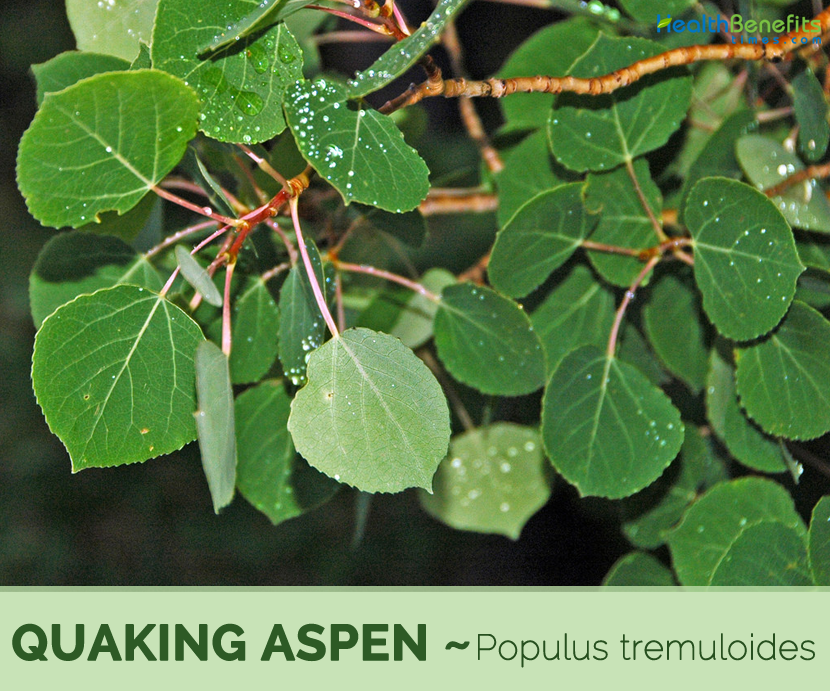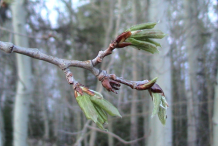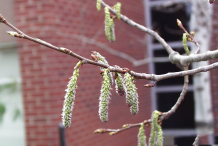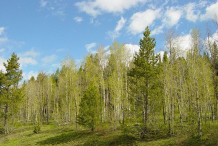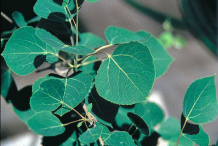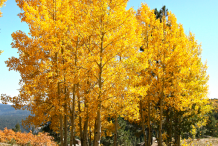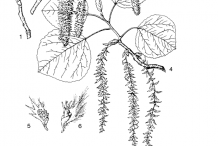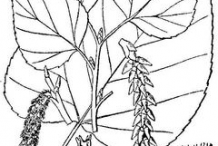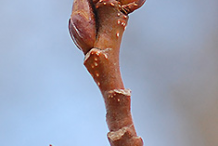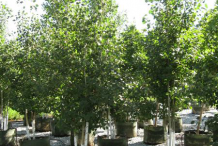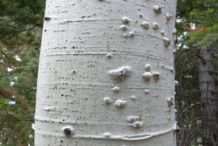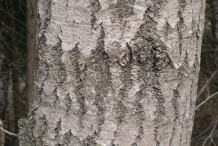Plant
Quaking aspen is a small- to medium-sized, fast-growing, and short-lived tree that grows about 20–25 m (66–82 ft.) tall. It is found growing in a range of soils from shallow, rocky or clay soils to rich sandy ones. It grows best in rich porous soils with plenty of lime. Growth is much less on wet soils, on poor acid soils and on thin dry soils. Roots are relatively shallow and widely spreading. Trunk is 20–80 cm (0.66–2.62 ft) in diameter and has comparatively smooth, colored greenish-white to gray bark, and is marked by thick black horizontal scars and prominent black knots.
Leaves
Leaves on mature trees are nearly round, 4–8 centimeters (1.6–3.1 in) in diameter with small rounded teeth, and a 3–7 centimeters (1.2–2.8 in) long, flattened petiole. Young trees (including root sprouts) have much larger—10–20 centimeters (3.9–7.9 in) long—nearly triangular leaves. The leaves change from green to golden and sometimes bright red in the fall.
Flower & Fruit
Flowers are catkins 4–6 centimeters (1.6–2.4 in) long, produced in early spring before the leaves; it is dioecious, with male and female catkins on different trees. Catkins are gray-green and not showy. Small drooping fruiting clusters follow the female flowers in late May. Fruits are 10-centimeter-long (3.9 in) pendulous string of 6-millimeter (0.24 in) capsules, each capsule containing about ten minute seeds surrounded in cottony fluff, which aids wind dispersal of the seeds when they are mature in early summer. Aspens are widely used in the timber industry to make pallets, crates, paper, pulpwood, and playgrounds. It is highly valuable for shipping purposes (i.e., crates, boxes, packing) because of its light weight and strength. It is widely preferred for making playgrounds because it does not splinter easily.
Traditional uses and benefits of Quaking Aspen
- It was widely employed medicinally by many native North American Indian tribes who valued it especially for its antiseptic and analgesic qualities, using it in the treatment of wounds, skin complaints and respiratory disorders.
- Stem bark is anodyne, anti-inflammatory, antiseptic, astringent, diaphoretic, diuretic, febrifuge, nervine and stimulant.
- Bark contains salicylates, from which the proprietary medicine aspirin is derived.
- It is used internally in the treatment of rheumatism, arthritis, gout, lower back pains, urinary complaints, digestive and liver disorders, debility, anorexia, also to reduce fevers and relieve the pain of menstrual cramps.
- Bark is used to treat chilblains, hemorrhoids, infected wounds and sprains.
- An infusion of the inner bark is considered to be a remedy for coughs and an appetite stimulant.
- It is also used in the treatment of stomach pains, urinary ailments, VD, worms, colds and fevers.
- Root is poultice and applied to cuts and wounds.
- Tea from the root bark is used as a treatment for excessive menstrual bleeding.
- Leaf buds are used as a salve for colds, coughs and irritated nostrils.
- It has been as a diuretic in urinary affections, gonorrhea and gleet.
- Infusion has been found helpful in debility, chronic diarrhea, etc.
- It has been used as a treatment for gonorrhea.
- Native American uses of this plant include root bark tea for excessive menstrual flow.
- Poultices made of the root are used for cuts and wounds.
- Tea made of the inner bark is beneficial for venereal disease, stomach pain, urinary ailments, worms, colds, and fevers.
- Leaf buds may be used in a salve for colds, coughs, and irritated nostrils.
- Tincture of the bark contains salicin and is a remedy for fevers, rheumatism, arthritis, and diarrhea.
- Buds are slightly sticky and can be made into tea or salve for internal or external use.
- Boil the buds in olive oil or lard to make a soothing salve.
- Aspen has been used externally as a wash for inflammations, cuts scratches, wounds and burns.
- Tea may be used for coughs or gargle for sore throat.
Culinary Uses
- Inner bark raw or cooked can be dried, ground into a powder and used as flour.
- This is normally mixed with other flours for making bread etc. and can also be used as a thickener in soups.
- Sap can be tapped and used as a drink.
- It has also been used as a flavoring with wild strawberries.
- Catkins can be consumed raw or cooked.
Uses
Industry
Quaking aspen is an important fiber source, especially for pulp, flake-board, and other composite products. Wood is light and soft with little shrinkage and is used for pallets, boxes, veneer, and plywood. Higher grades are used for other solid wood products, such as paneling, furniture components, and flooring. The wood characteristics make it useful in miscellaneous products, including excelsior, animal bedding, matchsticks, toys, beehives, tongue depressors, spoons, and ice cream sticks. It makes good playground structures because the surface does not splinter, although the wood warps and susceptible to decay.
Conservation
Quaking aspen is appreciated for its white bark and brilliant fall color, particularly when clustered. The species been widely used in landscaping but is best in sites away from structures that might be damaged by the aggressive roots. The trees provide good visual screening and noise abatement.
Aspen stands are good firebreaks, often dropping crown fires in conifer stands to the ground when they reach aspens and even sometimes extinguishing the fire because of the small amount of flammable accumulation. They allow more ground water recharge than do conifer forests and they also play a significant role in protecting against soil erosion. They have been used in restoration of riparian habitats.
Wildlife
Young quaking aspen provides food and habitat for a variety of wildlife: black bear, deer, beaver, porcupine, elk, moose, ruffed grouse and many smaller birds and animals, including small mammals such as mice, voles, shrews, chipmunks, and rabbits. Bark, buds, new sprouts, twigs from the tops of fallen or logged trees, and fallen leaves all are wildlife foods.
Ethno botanic
Native Americans used Populus bark (including aspen) as a food source. They cut the inner bark into strips, dried and ground it into meal to be mixed with other starches for bread or mush. Catkins were eaten raw, and the cambium was eaten raw or in a soup.
Other Facts
- Bark has been used to make hats.
- Bark has occasionally been used for cordage.
- Wood is soft, light, weak, close-grained, and rather woolly in texture, without smell or taste, of low flammability, not durable, very resistant to abrasion.
- Wood is not strong enough for furniture or construction; it is occasionally used for fences, railings and barn doors.
- It is excellent for cheap crates and boxes and is widely used for pulp, producing a high quality paper.
- Wood has been used to make particle board, strand board, and plywood.
- It has also been used to make toothpicks, sauna benches, and wooden structures for playgrounds.
- Oldest Quaking Aspen tree recorded is 226 years in Alaska.
- Mountain slopes covered by quaking aspen provide high yields of good-quality water.
- Yellow, orange, and red foliage of autumn particularly enhances recreational value of quaking aspen sites
- Quaking aspen is widely used in ornamental landscaping.
- Leaves serve as food for caterpillars of various moths and butterflies.
- The white powder found on the outer bark makes a good emergency sunscreen.
- Twigs can be chewed to fiber, and used to good effect as a toothbrush.
Precautions
- Possible toxic effects due to salicylates (e.g. heartburn, tinnitus).
- Avoid with ulcers, stomach or peptic ulcers.
- It should be avoided by ladies who are pregnant and also by breastfeeding women.
References:
https://www.itis.gov/servlet/SingleRpt/SingleRpt?search_topic=TSN&search_value=195773#null
https://davesgarden.com/guides/pf/go/54165/
https://npgsweb.ars-grin.gov/gringlobal/taxonomydetail.aspx?id=29424
http://www.pfaf.org/User/Plant.aspx?LatinName=Populus+tremuloides
http://www.missouribotanicalgarden.org/PlantFinder/PlantFinderDetails.aspx?kempercode=a895
http://www.botanical.com/botanical/mgmh/p/poplar61.html
https://plants.usda.gov/core/profile?symbol=potr5
https://www.cabi.org/isc/datasheet/43579
http://online.sfsu.edu/bholzman/courses/Fall99Projects/aspen.htm
https://en.wikipedia.org/wiki/Populus_tremuloides
Comments
| Quaking Aspen Quick Facts | |
|---|---|
| Name: | Quaking Aspen |
| Scientific Name: | Populus tremuloides |
| Origin | Cooler areas of North America |
| Shapes | 10-centimeter-long (3.9 in) pendulous string of 6-millimeter (0.24 in) capsules |
| Taste | Bitter, Acrid taste |
| Name | Quaking Aspen |
|---|---|
| Scientific Name | Populus tremuloides |
| Native | Cooler areas of North America |
| Common Names | American Aspen, Poplar, Quaking aspen, White Poplar, trembling aspen, golden aspen, mountain aspen, popple, trembling poplar, popple, aspen |
| Name in Other Languages | Canada: Aspen Cree: Mayîmiyitos English: Aspen Popular, quaking aspen, Trembling Aspen Finnish: Amerikanhaapa French: Peuplier faux-tremble; peuplier tremble d’Amerique Germany: Amerikanische Zitter- Pappel Italy: pioppo tremolo d’America Mexico: Alamo blanco; álamo temblón Spanish: Alamo blanco, álamo temblón USA: Aspen, golden aspen, mountain aspen, trembling poplar |
| Plant Growth Habit | Small- to medium-sized, fast-growing, and short-lived tree |
| Soil | Found in a range of soils from shallow, rocky or clay soils to rich sandy ones. It grows best in rich porous soils with plenty of lime. Growth is much less on wet soils, on poor acid soils and on thin dry soils |
| Plant Size | Up to 20–25 m (66–82 ft) |
| Root | Relatively shallow and widely spreading. |
| Bark | Comparatively smooth, colored greenish-white to gray, and is marked by thick black horizontal scars and prominent black knots |
| Trunk | 20–80 cm (0.66–2.62 ft) in diameter |
| Leaf | Leaves on mature trees are nearly round, 4–8 centimeters (1.6–3.1 in) in diameter with small rounded teeth, and a 3–7 centimeters (1.2–2.8 in) long, flattened petiole. Young trees (including root sprouts) have much larger—10–20 centimeters (3.9–7.9 in) long—nearly triangular leaves. The leaves change from green to golden and sometimes bright red in the fall. |
| Flowering Periods | April |
| Flower | Flowers are catkins 4–6 centimeters (1.6–2.4 in) long, produced in early spring before the leaves; it is dioecious, with male and female catkins on different trees. |
| Fruit | 10-centimeter-long (3.9 in) pendulous string of 6-millimeter (0.24 in) capsules, each capsule containing about ten minute seeds embedded in cottony fluff, which aids wind dispersal of the seeds when they are mature in early summer. |
| Flavor/Aroma | No odor |
| Taste | Bitter, Acrid taste |
| Plant Parts Used | Bark |
| Season | May to June |
| Varieties |
|
| Lifespan | Maximum age of about 200 years (oldest recorded is 226 years) in Alaska |


